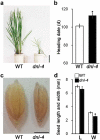Characterization of dwarf and narrow leaf (dnl-4) mutant in rice
- PMID: 33300429
- PMCID: PMC7849693
- DOI: 10.1080/15592324.2020.1849490
Characterization of dwarf and narrow leaf (dnl-4) mutant in rice
Abstract
Height and leaf morphology are important agronomic traits of the major crop plant rice (Oryza sativa). In previous studies, the dwarf and narrow leaf genes (dnl1, dnl2 and dnl3) have identified in rice. Using the Ac/Ds knockout system, we found a new dwarf and narrow leaf (dnl) mutant and identified mutated gene. The dnl-4 mutant showed reduced plant height and leaf blade width compared to the wild type, and increased leaf inclination. The morphological defects of the mutant were caused by the suppressed expression of the DNL-4 gene, which encodes a pfkB carbohydrate kinase protein. These results suggest that DNL-4 expression is involved in modulating plant height and leaf growth. Furthermore, DNL-4 expression also affects productivity in rice: the dnl-4 mutant exhibited reduced panicle length and grain width compared with the wild type. To understand DNL-4 function in rice, we analyzed the expression levels of leaf growth-related genes, such as NAL1, NAL7, and CSLD4, in the dnl-4 mutant. Expression of NAL1 and NAL7 was downregulated in the dnl-4 mutant compared to the wild type. The observation that DNL-4 expression corresponded with that of NAL1 and NAL7 is consistent with the narrow leaf phenotype of the dnl-4 mutant. These results suggest that DNL-4 regulates plant height and leaf structure in rice.
Keywords: Oryza sativa; Dwarf and narrow leaf mutant; pfkB carbohydrate kinase protein.
Figures






References
-
- Denning, G.L. & Mew, T.W., 1997. China and IRRI” Improving China's rice productivity in the 21st century. IRRI Discussion Papers 287591, International Rice Research Institute (IRRI).
-
- Lang YZ, Zhang ZJ, Gu XY, Yang JC, Zhu QS. Physiological and ecological effects of crimpy leaf character in rice (Oryza sativa L.) II. Photosynthetic character, dry mass production and yield forming. Acta Agron Sin. 2004;30:883–887.
Publication types
MeSH terms
Substances
LinkOut - more resources
Full Text Sources
Other Literature Sources
